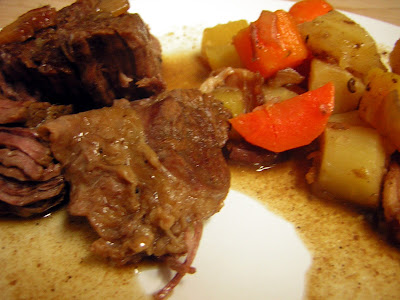We used two 2-pound pieces because that is what was available, and did not tie anything up with twine...it worked out fine. :)
 Beer Braised Pot Roast (recipe from Fine Cooking)
Beer Braised Pot Roast (recipe from Fine Cooking)serves 6
2 sprigs fresh sage (or 1/2 tsp. dried)
5 whole black peppercorns
1 4-lb. boneless beef chuck pot roast
Kosher salt and freshly ground black pepper
2 Tbs. vegetable oil
5 oz. thick-sliced (1/4 inch) bacon, cut into 1/2-inch squares (to yield 1 cup)
1-1/2 cups finely chopped onions
1/4 cup balsamic vinegar
1-1/2 cups beer or ale
1-1/2 cups homemade or low-salt chicken or beef broth
2 cups peeled, diced carrots (3/4-inch chunks)
2 cups peeled, diced parsnips (3/4-inch chunks)
2 cups peeled, diced rutabagas (3/4-inch chunks)
1 Tbs. Dijon mustard or prepared horseradish
2. Lower the heat to medium, add the bacon, and cook until just browned and beginning to crisp, 5 to 8 minutes. Remove the pot from the heat. With a slotted spoon, transfer the bacon to the plate with the beef. Spoon 2 Tbs. of the fat from the pan into a small dish and discard the rest.
3. Evaluate the drippings on the bottom of the pot. They may be very dark, almost black, but if there are any scorched bits, wipe these out with a wadded paper towel (if in doubt, taste a fleck; as long as it doesn't taste acrid, it's fine). Return the pot to medium heat and add the 2 Tbs. reserved fat. Add the onions, season with salt and pepper, and cook until they start to soften, about 5 minutes.
4. Deglaze and braise: Add the balsamic vinegar, stirring with a wooden spoon to scrape up any remaining drippings on the bottom of the pot if necessary. Bring to a boil over high heat, and cook until the liquid has reduced to about 2 Tbs.
5. Add the beer, beef or chicken broth, and the cheesecloth pouch of flavorings to the pot. Bring the liquid to a simmer. There should be at least 1 inch of liquid in the pot. Add more broth or beer if needed. Return the meat to the pot, along with the bacon and any juices that have accumulated. Return the liquid to a simmer, and cover the pot with a sheet of parchment, pushing down so the paper touches the meat. Set the lid in place. Slide the pot into the oven and cook for 2 hours, turning the roast with tongs after 1 hour.
6. Turn the roast over once more and then scatter the carrots, parsnips and rutabagas into the liquid around the roast. Continue braising, covered with the parchment and the lid, until the meat is fork-tender, about an hour longer. Test for doneness by spearing the meat toward the center with a carving fork. Pull out the fork carefully: If it lifts the meat along with it, continue cooking for another 20 to 30 minutes.
7. Transfer the pot roast and vegetables to a shallow platter (don't worry if a few chopped onions or bits of bacon come along too); tent with foil. Strain the remaining liquid into a measuring cup, discarding the spent onion and bacon, and the cheesecloth sachet of flavorings. Let the fat rise to the surface and spoon it off [We had a tough time getting the fat skimmed off, but our sauce tasted just fine]. Wipe out the braising pot with a paper towel.
8. Return the strained juices to the pot and bring to a simmer over medium heat. Taste and evaluate. If the flavor seems weak, simmer vigorously over medium-high heat to reduce the volume and concentrate the flavor, 5 to 15 minutes; season to taste with salt and pepper. Whisk in Dijon mustard or prepared horseradish.
9. Snip the strings from the pot roast and carve the meat across the grain into 1/4- to 1/2-inch-thick slices. Arrange the meat on a serving platter. Ladle about half the sauce over all, garnish with the vegetables, and serve, passing the remaining sauce at the table.
No comments:
Post a Comment